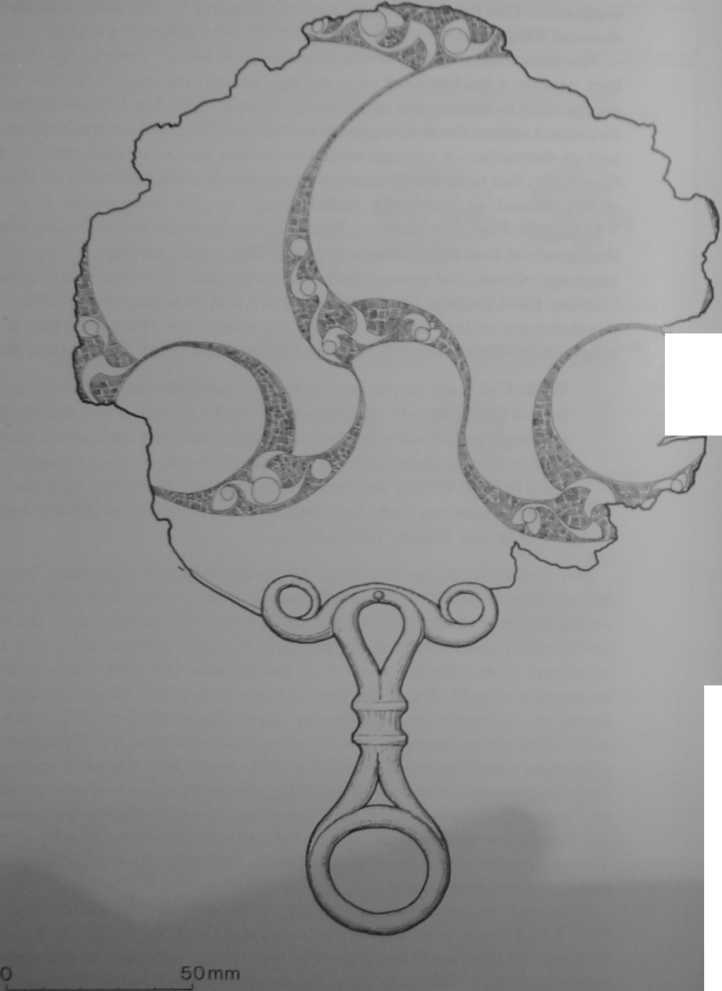S5004028
PCoins and pcwer in Lare Iron Age Britain

Fik |.8 Baakctry compaaa-work on che Latchmerc Hcath Mirror (drawing by S. Allen)
Mercury and Rosmerta, because of their sheer number, and those of Cemunnus and Epona, which rarely have much in the way of epigraphy associated with them.
The number of sculptures including Mercury perhaps signifies his condnued importance from pre-Roman times, when Caesar reported that Mercury was pre-eminent amongst the gods of the Gauls (BG 6.17). Mercury has various characteris-tics associated with him which are very reminiscent of shamanic practices. He is a tra\ cllcr and flyer, and in classical mythology he is the link between the real world and the underworld.
1 cmunniu is represented as a cross-legged małe wearing a torc, with antlers gi ■ .ving out of his head. The image is not only found on Roman reliefs, but is also l ■ known from the Gundestrup cauldron (Olmstead 1979) and the Peterborough 1 (0’Connell and Bird 1994:93). The therianthropic character of this figurę has .. lonally led to discussions about shamanisdc practices in relation to the image
• .he Gundestrup cauldron. The depiedon of a therianthrope wearing a torc ibines several of the images of power which have been discussed.
1 pona is described as a horse goddess, and she is found across much of central and northem Ga ul. In much of the sculpture she is represented as a woman riding a horse, though along the Rhineland she is often simply with horses, and in a few cases we just have the horses alone. As far as the nodons of trance are concemed, the image from a shrine in Burgundy showing her sleeping at the foot of a marę is pardcularly redolent (Wood 1992:126). Most people are happy to believe that this was a horse god/goddess which had taken on anthropomorphic form after the conąuest (Wood 1992). Certainly Continental coins exist showing a horse framed by a tempie, which suggests that the animal was regarded as either a divinity or at least sacred (Fig. 2.6: BN7050 from the Seine valley). Perhaps there are undertones of a woman/horse metamorphosis in this imagery, or perhaps we are dealing with indigenous represen-tations of a figurę which was once heavily symbolic of sovereignty, and is better seen in terms of the complex process of cultural interaedon in post-conquest Ga ul.
The idea that certain individuals experienced altered States of consciousness in MIA/LIA Britain should not be pardcularly contentious. The trance experience is pretty universal to nearly all societies, with the main difference being that cultures have varying atdtudes to the experience, and in many it is confined to a pardeular proportion of the community. Often this results in the development of a specialist class dealing with this other-world, for example the shaman of Siberia. Shaman is a term which has been loosely used in the ethnographic literaturę to describc almost any class of individuals specialising in reladons between the earth-bound and trance worlds. The case has been madę for such practices in Neolithic and Bronze Age Britain, first by Bradley (1989), then tested and developed by Dronfield (1993; 1995) and now appeąrs to be reasonably broadly accepted (cf. Bradley 1997). Since literary and archaeological evidence clearly demonstratę the classical world’s knowledge of pharmacological and psycho-active substances, it is only in the intervening period of the Iron Age that the manifestadon of the trance experience within society has not been discussed.
Furthermore, most discussions of ASCs on the basis of prehistorie ‘art’ in Britain
Wyszukiwarka
Podobne podstrony:
S5004023 Coins and power in Lata Iron Age Britain 40 to have been taken over the colour of the early
S5004027 Coins and power in Late Iron Age BritainThe various stages of t rance imagery Coins and pow
S5004029 Coins and potuer in Late Iron Age Britain 52 and some other areas have only gone so far as
46870 S5004024 Coins and power in Late Iron Age Britain 42 This effect was the primary driving lorce
S5004019 Coins and power in Ute Iron Age Britain British A VA200:E4 Gold Gallo-Bclgic A VA12:SEl-3 G
S5004022 Coins and potuer in Late Iron Age Britain 38 not gold, was used for the consecradon of king
więcej podobnych podstron